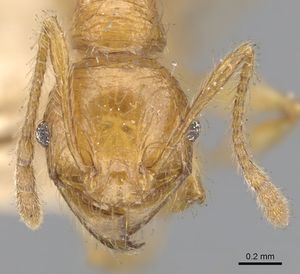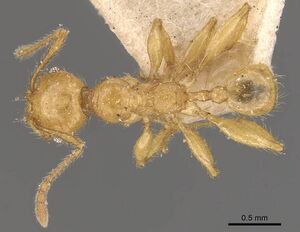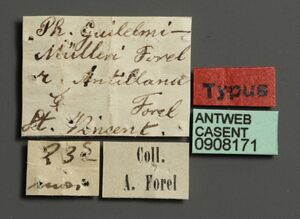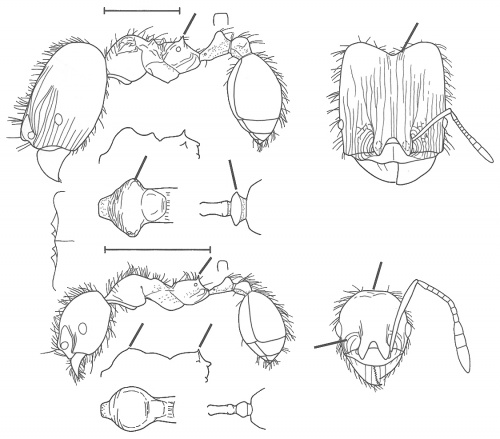Pheidole antillana
| Pheidole antillana | |
|---|---|

| |
| Scientific classification | |
| Kingdom: | Animalia |
| Phylum: | Arthropoda |
| Class: | Insecta |
| Order: | Hymenoptera |
| Family: | Formicidae |
| Subfamily: | Myrmicinae |
| Tribe: | Attini |
| Genus: | Pheidole |
| Species: | P. antillana |
| Binomial name | |
| Pheidole antillana Forel, 1893 | |
The following field notes by H. H. Smith (in Forel 1893) on St. Vincent match those made by Stefan Cover and me on Grenada in June 1995: "A common species in forest and shady places. The colonies are generally composed of one or two hundred individuals at most, but may have as many as six or seven hundred. The formicarium is generally under bark of very rotten logs, or under a log or stick; rarely under a stone or under turf on a rock. It is an irregular chamber, with short radiating passages, the whole commonly occupying only two or three inches of space. The workers major are few in number, sometimes only one or two in the colony. Both workers major and minor are sluggish, especially the former." Smith found seeds in at least one of the nests. Sexual forms were found by him in the nests in October and November, and by Charles T. Brues on Grenada in September. (Wilson 2003)
Identification
See the description in the nomenclature section.
Keys including this Species
Distribution
St. Vincent, Grenada, and Dominica. Stefan Cover and I failed to find antillana on Barbados, in spite of careful searching in forested habitats there. (Wilson 2003)
Latitudinal Distribution Pattern
Latitudinal Range: 15.45° to 12.059°.
| North Temperate |
North Subtropical |
Tropical | South Subtropical |
South Temperate |
- Source: AntMaps
Distribution based on Regional Taxon Lists
Neotropical Region: Dominica, Grenada, Guadeloupe, Lesser Antilles, St. Vincent.
Distribution based on AntMaps
Distribution based on AntWeb specimens
Check data from AntWeb
Countries Occupied
| Number of countries occupied by this species based on AntWiki Regional Taxon Lists. In general, fewer countries occupied indicates a narrower range, while more countries indicates a more widespread species. |

|
Estimated Abundance
| Relative abundance based on number of AntMaps records per species (this species within the purple bar). Fewer records (to the left) indicates a less abundant/encountered species while more records (to the right) indicates more abundant/encountered species. |

|
Biology
On Dominica this species is the host of the parasitic ant Solenopsis enigmatica (de la Mora et al., 2021; Deyrup & Prusak, 2008).
Castes
Worker
Minor
Images from AntWeb
   
| |
| Syntype of Pheidole guilelmimuelleri antillana. Worker. Specimen code casent0901479. Photographer Will Ericson, uploaded by California Academy of Sciences. | Owned by OUM, Oxford, UK. |
   
| |
| Syntype of Pheidole antillana. Worker. Specimen code casent0908171. Photographer Will Ericson, uploaded by California Academy of Sciences. | Owned by MHNG, Geneva, Switzerland. |
Nomenclature
The following information is derived from Barry Bolton's Online Catalogue of the Ants of the World.
- antillana. Pheidole guilelmimuelleri r. antillana Forel, 1893g: 401 (s.w.q.m.) ANTILLES. Raised to species: Wilson, 2003: 654.
Unless otherwise noted the text for the remainder of this section is reported from the publication that includes the original description.
Description
From Wilson (2003): DIAGNOSIS Similar to Pheidole avia, Pheidole bucculenta, Pheidole guilelmimuelleri, Pheidole hetschkoi, Pheidole heyeri, Pheidole hortonae, Pheidole praeses, Pheidole rhytifera and Pheidole sarcina of South America, as well as Pheidole mamore of the scrobifera group, but differing in the following combination of traits.
Major: antennal scrobe absent; strong medium-length propodeal spines present; carinulae originating on the frontal lobes mostly approach or reach the occiput; intercarinular spaces of cephalic dorsum smooth and shiny; humerus rugoreticulate.
Minor: occiput narrow but lacking a nuchal collar; humerus denticulate in dorsal-oblique view; carinulae on head confined to area mesad and anterior to the eyes and several broken lines on the occiput; carinulae on pronotum sparse and limited to anterior margin.
Color varies from yellow to dark brown, as part of geographic variation among different island populations.
MEASUREMENTS (mm) Holotype major: HW 1.56, HL l.72, SL 0.74, EL 0.16, PW 0.80. Paratype minor: HW 0.66, HL 0.72, SL 0.76, EL 0.10, PW 0.66.
COLOR The material I have examined varies according to the island of origin: reddish yellow on St. Vincent (types); light reddish brown to dark brown on Grenada; and light reddish brown on Dominica.
Figure. Upper: syntype, major. Lower: syntype, minor. Scale bars = 1 mm.
Type Material
From Wilson (2003): ST. VINCENT: West Indies, col. H. H. Smith. Musee d'Histoire Naturelle Genève and Museum of Comparative Zoology - as reported in Wilson (2003)
Etymology
Named after the Antilles, the native region of the species. (Wilson 2003)
References
- Wilson, E. O. 2003. Pheidole in the New World: A dominant, hyperdiverse ant genus. Harvard University Press, Cambridge, MA. (page 654, fig. major, minor described)
- Deyrup, M. and Z. A. Prusak. 2008. Solenopsis enigmatica, a new species of inquiline ant from the island of Dominica, West Indies (Hymenoptera: Formicidae). Florida Entomologist. 91:70-74.
- Forel, A. 1893j. Formicides de l'Antille St. Vincent, récoltées par Mons. H. H. Smith. Trans. Entomol. Soc. Lond. 1893: 333-418 (page 401, soldier, worker, queen, male described)
- Meurgey, F. 2020. Challenging the Wallacean shortfall: A total assessment of insect diversity on Guadeloupe (French West Indies), a checklist and bibliography. Insecta Mundi 786: 1–183.
- Wetterer, J.K. 2021. Ants (Hymenoptera, Formicidae) of St. Vincent, West Indies. Sociobiology 68, e6725 (doi:10.13102/sociobiology.v68i2.6725).
References based on Global Ant Biodiversity Informatics
- Deyrup, M. and Z.A. Prusak. 2008. Solenopsis enigmatica, a new species of inquiline ant from the island of Dominica, West Indies (HymenopteraL Formicidae). Florida Entomologist 91(1): 70-74
- Deyrup, Mark and Zachary A. Prusak. 2008. Solenopsis enigmatica, A New Species of Inquiline Ant From the Island of Dominica, West Indies. Florida Entomologist 91(1):70-74.
- Galkowski C. 2016. New data on the ants from the Guadeloupe (Hymenoptera, Formicidae). Bull. Soc. Linn. Bordeaux 151, 44(1): 25-36.
- Kempf, W.W. 1972. Catalago abreviado das formigas da regiao Neotropical (Hym. Formicidae) Studia Entomologica 15(1-4).
- Wheeler W. M. 1905. The ants of the Bahamas, with a list of the known West Indian species. Bulletin of the American Museum of Natural History 21: 79-135.
- Wilson, E.O. 2003. Pheidole in the New World: A Dominant, Hyperdiverse Genus. Harvard University Press



